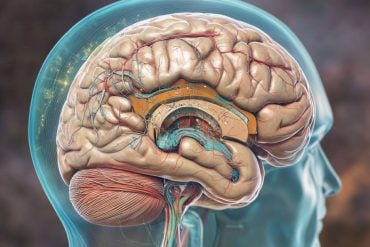Summary: Alpha-2-adrenergic agonists appear to be effective at reducing symptoms associated with ADHD in preschool-aged children, and have fewer side effects than traditional stimulants used to treat ADHD.
Source: Boston Children’s Hospital
About 2.4 percent of preschool-age children have an attention-deficit/hyperactivity disorder (ADHD) diagnosis. For these children, behavioral interventions intended to redirect a child or otherwise replace negative behaviors with positive ones are the first line of treatment. But what if symptoms linger, or are so severe that they interfere with a child’s social, emotional, and educational development?
A study from Boston Children’s Hospital finds that starting drug treatment with alpha-2-adrenergic agonists (A2As), such as guanfacine and clonidine, can be effective in reducing ADHD symptoms in preschool-age children. Just as important, the study shows that these medications have fewer side effects than stimulants, like methylphenidate (Ritalin, Concerta) and amphetamines (Adderall, Vyvanse), which are often the first line of ADHD treatment.
A2As were initially used to regulate blood pressure in adults but then gained FDA approval to treat ADHD in school-aged children after clinical trials found they could improve attention and focus and reduce ADHD symptoms.
Results of this ADHD/A2A study are published in JAMA. It is the first analysis of the effects of both stimulants and A2As in preschool children.
One-third of children already taking A2A medications
A team from the Developmental Behavioral Pediatrics Research Network (DBPNet), which includes Boston Children’s, reviewed the medical records of nearly 500 children seen at seven outpatient developmental-behavioral pediatric practices.
“We found that about 35 percent of preschool-age children with ADHD began drug treatment with A2A medications, even though little is known about their effectiveness and safety in this age group,” says lead author Elizabeth Harstad, MD, MPH, of the Division of Developmental Medicine at Boston Children’s. “Since these kids are already being prescribed these drugs, it was important to study their effectiveness and possible adverse effects.”

The median age of the children in the study was just over 5 years old; 82 percent were male.
A2As nearly as effective as stimulants
Of the 497 children in the study, 309 (62 percent) had first received behavioral therapy before initiating ADHD medication, in line with current ADHD treatment recommendations from the American Academy of Pediatrics.
Lower rate of side effects with A2As
Daytime sleepiness was the only adverse side effect that developed more frequently in children who were started on A2As compared with stimulants (38 percent vs 3 percent).
“However, for stimulants, there were several side effects that were reported more frequently than for the kids that had been initiated on A2A medication,” says Harstad.
The most common negative effects between stimulants and A2As were:
- moodiness/irritability (50 percent vs. 29 percent)
- appetite suppression (38 percent vs. 7 percent)
- difficulty sleeping (21 percent vs. 11 percent)
- increased stomachaches (13 percent vs. 5 percent)
- Increased skin picking/repetitive behaviors (11 percent vs. 5 percent)
“The fact is that children taking the A2As had fewer difficulties with these side effects,” says Harstad.
An encouraging follow-up study
An earlier landmark study conducted elsewhere, called the Preschool ADHD Treatment Study (PATS), found that treatment with the stimulant methylphenidate significantly reduced ADHD symptoms in children between the ages of 3 to 5.5 years. But, more than 40 percent of children had irritability while taking it; more than 20 percent experienced crying or were tearful, sad, or depressed.
“This is an important next step after the PATS study that now shows that A2As can provide nearly equivalent ADHD symptom relief with fewer frequent adverse effects,” says Dr. Harstad.
About this ADHD research news
Source: Boston Children’s Hospital
Contact: Alice McCarthy – Boston Children’s Hospital
Image: The image is credited to Sebastian Stankiewicz, Boston Children’s
Original Research: Closed access.
“α2-Adrenergic Agonists or Stimulants for Preschool-Age Children With Attention-Deficit/Hyperactivity Disorder” by Elizabeth Harstad et al. JAMA
Abstract
α2-Adrenergic Agonists or Stimulants for Preschool-Age Children With Attention-Deficit/Hyperactivity Disorder
Importance
Attention-deficit/hyperactivity disorder (ADHD) is diagnosed in approximately 2.4% of preschool-age children. Stimulants are recommended as first-line medication treatment. However, up to 25% of preschool-age children with ADHD are treated with α2-adrenergic agonist medications, despite minimal evidence about their efficacy or adverse effects in this age range.
Objective
To determine the frequency of reported improvement in ADHD symptoms and adverse effects associated with α2-adrenergic agonists and stimulant medication for initial ADHD medication treatment in preschool-age children.
Design, Setting, and Participants
Retrospective electronic health record review. Data were obtained from health records of children seen at 7 outpatient developmental-behavioral pediatric practices in the Developmental Behavioral Pediatrics Research Network in the US. Data were abstracted for 497 consecutive children who were younger than 72 months when treatment with an α2-adrenergic agonist or stimulant medication was initiated by a developmental-behavioral pediatrician for ADHD and were treated between January 1, 2013, and July 1, 2017. Follow-up was complete on February 27, 2019.
Exposures
α2-Adrenergic agonist vs stimulant medication as initial ADHD medication treatment.
Main Outcomes and Measures
Reported improvement in ADHD symptoms and adverse effects.
Results
Data were abstracted from electronic health records of 497 preschool-age children with ADHD receiving α2-adrenergic agonists or stimulants. Median child age was 62 months at ADHD medication initiation, and 409 children (82%) were males. For initial ADHD medication treatment, α2-adrenergic agonists were prescribed to 175 children (35%; median length of α2-adrenergic agonist use, 136 days) and stimulants were prescribed to 322 children (65%; median length of stimulant use, 133 days). Improvement was reported in 66% (95% CI, 57.5%-73.9%) of children who initiated α2-adrenergic agonists and 78% (95% CI, 72.4%-83.4%) of children who initiated stimulants. Only daytime sleepiness was more common for those receiving α2-adrenergic agonists vs stimulants (38% vs 3%); several adverse effects were reported more commonly for those receiving stimulants vs α2-adrenergic agonists, including moodiness/irritability (50% vs 29%), appetite suppression (38% vs 7%), and difficulty sleeping (21% vs 11%).
Conclusions and Relevance
In this retrospective review of health records of preschool-age children with ADHD treated in developmental-behavioral pediatric practices, improvement was noted in the majority of children who received α2-adrenergic agonists or stimulants, with differing adverse effect profiles between medication classes. Further research, including from randomized clinical trials, is needed to assess comparative effectiveness of α2-adrenergic agonists vs stimulants.






